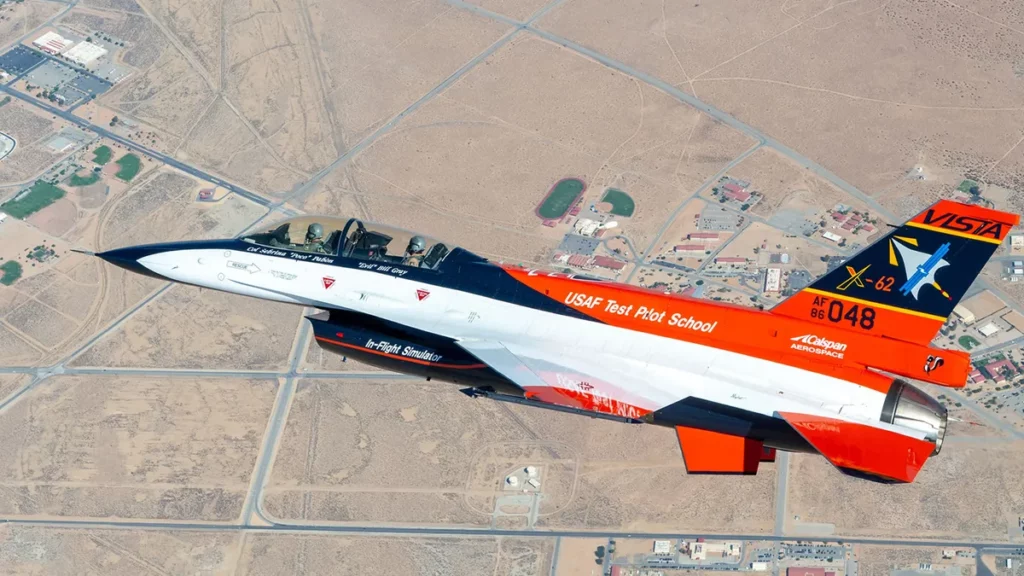
The skies were clear as the VISTA X-62A — a one-of-a-kind training aircraft built by Lockheed Martin on an F-16 platform — soared over the Mojave Desert. The cockpit of the high-tech jet is littered with expensive and highly sensitive avionics that enable pilots to perform their missions. But the designers could have crammed in even more technology if it were not for the two pilot seats. Their wish might come true in the not-so-distant future. That’s because this was not your regular sortie.
The training jet was recently reported to have flown 17 hours entirely operated by an artificial intelligence (AI) system, which could open the floodgates for completely autonomous jet fighters and drones. This is the first time that an AI has flown a tactical aircraft for this long.
How the U.S. Air Force is betting on AI
The VISTA X-62 is perhaps the most powerful and versatile training jet in the world. It’s essentially an upgraded F-16D with Block 40 avionics installed, but with a lot of room for installing and trying out different hardware quickly and easily, that mimics the flight controls of other aircraft, enabling the aircraft itself to act as its own ground simulator. Those who’ve flown the X-62 describe it as a Swiss army knife that they can use to attach lots of different things to the airplane.
Perhaps, the most powerful feature of the X-62 is the ease with which software can be changed on the fly. Since December, the U.S. Air Force has mounted and tested at least two completely different AI systems on the X-62, namely DARPA’s Air Combat Evolution (ACE) and the Air Force Research Laboratory’s Autonomous Air Combat Operations (AACO).
These AI systems are essential for the Air Force’s ambitions to field a completely autonomous combat drone by as early as 2024, a counterpart for its sixth-generation stealth fighter that is supposed to transform air combat forever. The Air Force’s vision is to have one of these upcoming sleek new manned fighters coordinate a mini-fleet of five to six so-called Collaborative Combat Aircraft (CCAs) that provide a widening sphere of missions in support of air dominance, air attack, surveillance, and forward weapons delivery. In fact, the possibilities are endless now that the Pentagon is able to demonstrate the ability for cargo aircraft to launch and also “recover” drones with its Gremlins program.
“Since its original inception, it has been all about a family of systems, so I think the real question is, how can we tie in some of these other capabilities that we’ve been talking about with uncrewed systems, collaborative partners, and so forth?” said Chris Ristich, Director of the Integrated Capabilities Directorate of the Air Force Research Laboratory at Wright-Patterson Air Force Base in Ohio.
The new VISTA X-62, which was upgraded with state-of-the-art simulation, model following algorithm, and autonomous control systems, gives us a taste of what’s to come in terms of autonomous flight — although it’s worth noting that a human pilot was ready to step in at any time and retake control of the aircraft.
“VISTA will allow us to parallelize the development and test of cutting-edge artificial intelligence techniques with new uncrewed vehicle designs,” said Dr. M. Christopher Cotting, U.S. Air Force Test Pilot School director of research. “This approach, combined with focused testing on new vehicle systems as they are produced, will rapidly mature autonomy for uncrewed platforms and allow us to deliver tactically relevant capability to our warfighter.”
In terms of cost, the Air Force wants drones that are no more than half the cost of an F-35 — which would put the most high-end CCAs at about $40 million, though researchers at Boeing, Lockheed Martin and Northrop Grumman are aiming for a factor lower than that.
“The expectation is that these aircraft can be designed to be less survivable and less capable, but still bring an awful lot to the fight in a mixture that the enemy has a very hard time sorting out and dealing with,” Air Force Secretary Frank Kendall said during an interview with Breaking Defense. “You can even intentionally sacrifice some of them to draw fire, if you will, to make the enemy expose himself.”
Of course, the United States Air Force is not alone. The UK, Japan, and Italy announced plans in late 2022 that will see the three countries team up to build a sixth-generation stealth fighter jet that would rival and perhaps eclipse the best that the likes of China, Russia, and even ally United States are working on.









